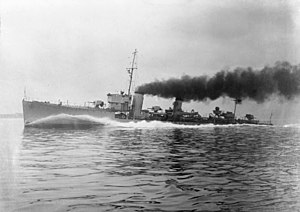
| |
| History | |
|---|---|
| Name | HMS Seawolf |
| Ordered | June 1917 |
| Builder | John Brown & Company, Clydebank |
| Yard number | 480 |
| Laid down | 30 April 1918 |
| Launched | 2 November 1918 |
| Completed | 28 January 1919 |
| Out of service | 23 February 1931 |
| Fate | Sold to be broken up |
| General characteristics | |
| Class and type | S-class destroyer |
| Displacement | |
| Length | 265 ft (80.8 m) p.p. |
| Beam | 26 ft 9 in (8.15 m) |
| Draught | 9 ft 10 in (3.00 m) mean |
| Propulsion |
|
| Speed | 36 knots (41.4 mph; 66.7 km/h) |
| Range | 2,750 nmi (5,090 km) at 15 kn (28 km/h) |
| Complement | 90 |
| Armament |
|
HMS Seawolf was an S-class destroyer that served with the Royal Navy and, in 1922, was commanded by the future Admiral of the Fleet, John Tovey. Launched in 1918 just before the end of the First World War, the warship initially joined the torpedo school at Devonport before, in 1919, serving briefly in the Latvian War of Independence. Subsequently deployed to Ireland, the vessel carried some of the bodies of the victims of Bloody Sunday to their funerals in 1920 and, in 1924, rescued the passengers and crew of the steamship Asian that had sunk in a storm near Queenstown. After the London Naval Treaty of 1930 restricted the tonnage of destroyers operated by the Navy, Seawolf was retired and, in 1931, was sold to be broken up.